
Nonprofit Boards And Planning Learning
Embark on a journey of mastery in board governance and strategic planning with our selected collection of educational videos– tailored exclusively for nonprofits. Venture into the intricate dynamics of board management, from recruitment and retention of effective board members to nurturing a culture of engagement and mutual respect. Explore the heart of strategic planning as nonprofit experts share compelling visions and means to devise actionable plans, and implement them successfully. You’ll learn how to synergize your board and staff and align them towards common goals and objectives. Whether you’re a newly formed nonprofit seeking structure and new board members or an established organization aiming to streamline processes and enhance impact, these inspiring learning sessions will give you a wealth of resources.
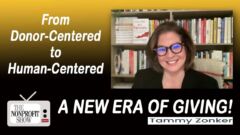
When fundraising meets humanity, transformation follows—and few express that better than Tammy Zonker, founder of Fundraising Transformed and author of Calling All Heroes. In this powerful episode, host Julia C. Patrick engages Tammy in a deep conversation about reimagining philanthropy through what she calls a human-centered mindset—a new evolution beyond donor- or community-centric models.
Tammy explains, “The human-centered mindset is fundamentally about recognizing that everyone involved in the philanthropic process brings unique value—lived experience, expertise, and contribution—all of which deserve to be respected and valued.” That respect, she notes, comes alive through five principles: listening, empathy, belonging, shared values, and authentic partnership. Each principle is deceptively simple but radically powerful in a world that’s become more divided and transactional.
After 17 years leading Fundraising Transformed, Tammy has seen the shift from transactional giving toward connection-based relationships that sustain missions, not just budgets. Yet, she reminds us that even well-intentioned donor-centered models can reinforce inequity when organizations let large gifts steer mission or silence truth. “We never had the courage to course-correct because we feared losing the funding,” she says candidly—a line that will resonate with fundraisers everywhere.
Her solution? Blend the best of both approaches. Donor-centered fundraising taught gratitude and impact reporting; community-centered fundraising elevated justice and inclusion. A human-centered model marries both, removing ego, flattening hierarchy, and restoring empathy across every role—donor, volunteer, staff, and participant.
Tammy ties this philosophy to the real data crisis in philanthropy: donor retention at just 43% overall and a mere 19% for first-time givers. With fewer households donating each year, she warns that philanthropy risks becoming an elite sport. Instead, she advocates re-elevating small monthly donors, volunteers, and advocates whose collective action drives real change.
The episode ends on a liberating message for nonprofit professionals: progress over perfection. Perfection, Tammy insists, “is overrated.” Real leadership requires risk, humility, and innovation—and that means acting, failing, learning, and trying again.
In a time when empathy often feels endangered, Calling All Heroes reminds us that every fundraiser, donor, and community member has a heroic role to play. Humanity, it seems, is the most sustainable fundraising strategy of all.
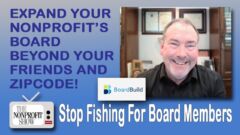
What happens when you stop fishing for board members in the same small pond and start casting into the ocean? According to TD Smyers, CEO and co-founder of BoardBuild.org, you get a board that actually reflects the people you serve and a lot more horsepower where it counts. TD admits he learned the hard way. Traditional recruiting leans almost entirely on the social circles of executives and current directors, which means sameness on repeat. BoardBuild flips that habit by opening a national pool and enabling a mutual search that matches what nonprofits need with candidates who are eager and prepared to serve.
TD frames diversity with refreshing specificity: race and ethnicity, age, gender, geography, and industry. The platform lets organizations search intentionally across those dimensions and beyond. Why it matters shows up in the results. A six-month study by Maya Consulting found that members sourced through the platform immediately energized strategic planning, governance, and fundraising. Board giving, often stuck around seventy percent participation nationally, moved upward as many of these new directors gave beyond their peers. That is not luck; that is design.
The modern boardroom, TD notes, isn’t limited by zip code. Remote participation widened the talent aperture without dulling performance. The real work, TD reminds us, happens between meetings—inside committees and follow-through—not during the quarterly roll call.
Two BoardBuild differentiators drive outcomes. First, the pool: “We built BoardBuild so there are no barriers to that pool,” TD says. No geographic, language, or socioeconomic walls. Second, the magic of mutual search: candidates define the causes and roles they want, organizations define the skills and lived experience they need, and “when passion and specificity meet the need, the magic happens.”
Funders are paying attention too. If you want smarter stewardship of grant dollars, strengthen the people making the decisions. Community foundations and statewide associations now use BoardBuild to help their grantees fortify boards with purpose and capacity. The net effect is a sector that collaborates more, competes smarter, and grows up a bit on boardroom practice. TD’ thesis is simple and persuasive: treat board service like the part-time job it really is, recruit from a larger world, and watch your organization’s strategy and resources stop wobbling.
#TheNonprofitShow #BoardGovernance #NonprofitLeadership
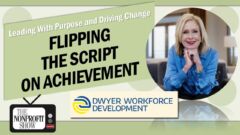
Dwyer Workforce Development is rewriting what “possible” looks like for a young, fast-scaling nonprofit. In this compelling conversation, CEO Barb Clapp traces a journey that began with a blank slate in September 2022 and now stands at 10,000 Dwyer Scholars across seven states—with a confident path to 100,000 by 2030. The spark came from founder Jack Dwyer’s twin commitments: expand opportunity for people shut out of stable careers and respond to the nationwide healthcare staffing crisis. Barb’s charge was bold—design a national model that moves quickly, performs consistently, and proves its value to partners, employers, and learners.
Her answer blends entrepreneurial rigor with social mission. Dwyer built a social enterprise engine—a $590 million conversion of a skilled nursing portfolio to nonprofit ownership—whose proceeds help fund training pathways. At ground level, the organization relies on clearly defined referral, training, and employer partnerships, each governed by MOUs and measurable expectations. That clarity enables adaptation to rural, suburban, and urban markets while maintaining one brand, one message, and one standard for outcomes. As Barb puts it, “My little motto is that press brings opportunity and having a consistent brand and understanding consistent messaging will improve outcomes.”
Communications discipline is not a tactic; it is strategy. Internal messaging aligns every team member on values, goals, and voice. External messaging earns trust, investment, and momentum. Boards and leaders who resist marketing spend, Barb notes, miss the compounding returns of consistent communication. The results are striking: rapid state expansion, strong completion and placement outcomes for scholars, and a repeatable market entry framework. States now approach Dwyer—Kansas and New York among them—because the model is explicit, execution-ready, and partnered from day one.
Barb’s leadership philosophy centers on kindness through candor. “Clarity is kindness… I’m like a street shooter, so no one really doesn’t understand what my expectations are.” That stance dignifies partners and scholars alike, and it fuels the organization’s capacity to scale technology, staff, and regional structures without losing its heart. The pandemic exposed both the fragility and heroism of healthcare work; Dwyer’s model honors that reality by opening doors to CNAs and other caregiving roles for individuals overcoming homelessness, domestic violence, and generational limits.
The takeaway is simple and ambitious: when mission meets enterprise discipline and brand coherence, systems begin to shift. Dwyer Workforce Development is proving that national growth and local responsiveness can move together—one clear message, one rigorous playbook, and thousands of new careers at a time.

When a nonprofit founder steps away, the organization often faces one of the most emotional and uncertain chapters in its history. In this episode, Joan Brown, Chief Operating Officer at Interim Executives Academy, and Catherine Bradshaw, Senior Search Specialist at EOS Transition Partners, discuss the delicate art of following a founder and building stability during leadership succession.
Catherine begins, “When a founder leaves, the organization loses not only a leader but often its very identity. The board and staff must learn that the mission can thrive beyond the individual.” Her experience reveals that many boards have never navigated a leadership change — especially one that involves the founder who is the face of the organization.
Joan adds, “Interim leaders give organizations breathing space. When there’s no heir apparent, an interim provides structure, clarity, and a safe period to determine what the future needs to look like.” She reminds us that interim executives aren’t caretakers—they’re catalysts for readiness, shaping communication and confidence at every level of the organization.
Together, they address the emotional realities that come when a founder steps aside: staff anxiety, donor unease, and the founder’s own sense of identity loss. Catherine recommends coaching and structured off-boarding as essential supports: “Departing leaders need grace and guidance too. It’s about leaving the organization strong and knowing when to step fully away.”
Joan highlights the power of communication: “No one functions well with prolonged uncertainty. Clear communication with staff, donors, and community partners makes all the difference in a smooth transition.” Both guests advocate early succession planning and the importance of professional interim leadership to prevent crisis-driven change.
From retaining donor trust to defining new leadership roles, this sparkling conversation reveals why founder transitions, when managed thoughtfully, can be a time of renewal rather than instability. It’s a masterclass for nonprofit boards, executives, and founders who want to lead with foresight rather than fear.
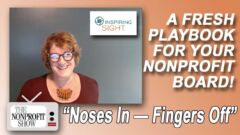
Boards don’t magically run themselves—and this lively discussion proves it. Strategist and facilitator Mary Kay Delvo of Inspiring Sight lays out a practical path for turning board service from a vague obligation into purposeful leadership. She starts with a truth we all feel: “If they knew better, they’d do better.” Most board members were never taught governance, so we must teach it—and then expect ownership.
Mary Kay reframes board work with a memorable mantra: protect and direct. Every decision should answer, How does this protect the organization and or direct it? Pair that with her second keeper—“Noses in, fingers off”—and you’ve got a fast filter for staying strategic without micromanaging.
Her signature Seasonal Board Cycle makes governance easy to see and easy to use:
· Spring – Plant and cultivate: recruit intentionally for perspectives you truly need.
· Summer – Engage effectively: spread work through committees so knowledge isn’t concentrated.
· Fall – Revitalize and harvest: measure real impact, not just attendance.
· Winter – Recharge and look ahead: scan for change, refine strategies, and celebrate wins.
On strategy, Mary Kay replaces the dusty plan with a Strategic Map—a living journey to a destination. The destination stays constant; routes change as conditions change. That’s why boards must revisit the map, assess detours, and make smart adjustments with staff. After the board approves the map, staff craft an Understanding Impact Map with goals, success indicators, reviews, and board reporting—so every meeting tracks progress, learns from misses, and recommends course corrections.
She also addresses the classic tension between boards setting direction and staff living the day-to-day. Her non-negotiable: senior leadership joins the board in mapping, and staff input is synthesized and heard. Otherwise there’s no buy-in—and without buy-in, plans gather dust.
Most of all, Mary Kay gives boards permission to be human. Seasons change. Routes shift. Progress accelerates when everyone knows the role they play and the questions they must ask. Or in her words: “Boards need to be responsible for their own succession, uation, and foresight.” When that happens, governance becomes energizing—and impact becomes visible.
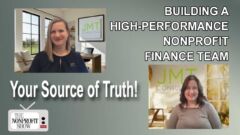
Nonprofits talk about programs, fundraising, and boards—but rarely about how to build and lead a modern finance team. JMT Consulting’s Taylor Bost and Samantha Tiso deliver a clear, practical playbook for turning finance from a back-office function into a strategic engine.
Samantha reframes the relationship right out of the gate: “We view the finance department as the customer support for the rest of the company.” That posture—service, responsiveness, and clarity—reduces fear, boosts collaboration, and speeds decisions. It also demands better systems. As she puts it, “With the right system… that is possible if you have it structured the right way.” Translation: good data in, fast insight out.
Taylor widens the lens to organization-wide alignment. Finance is not just P and L. It is grants, restrictions, repeat donor behavior, and cost to raise a dollar—metrics that reshape priorities across teams. That is why she pushes for a single ‘source of truth’ and warns against siloed tools: when data is scattered, people end up re-keying information and fixing errors. Her reminder lands: “Every time a human’s touching something… you’re opening yourself up to room for error.”
Measurement matters too—of the finance team itself. Taylor offers practical KPIs any CEO or board can use: monthly close time, volume of audit adjustments, and adoption of automation. If close cycles are drifting from 5–7 business days to 15–20, there is friction you can remove with better workflow, integrations, and roles.
Governance shows up repeatedly. Samantha adds: “The C-suite needs to be looking at it. The board needs to be looking at it.” Confidence in numbers is confidence in the organization. And with grantmakers demanding more frequent and better-substantiated reports, integrated systems are no longer optional—they are essential.
The quick-paced convo also tackles outsourced and remote finance. Success hinges on clear ownership of recurring tasks, documented deadlines, and transparent communication channels. Taylor’s advice: break the monthly engine into parts—reconciliations, payment application, approvals—so nothing stalls.
The icing on the cake? We get a preview of Innovate 2026 conference and JMT’s three-decade journey—from early outsourced accounting to full-stack finance technology and process advisory. Samantha shares how Innovate blends training with thought leadership on grants, banking, interest rates, and board communication, ensuring every role—from CFO to controller to ops—walks away with practical upgrades.
Big takeaway: modern nonprofit finance is a service mindset plus integrated tech plus shared accountability. Or in Taylor’s words, “CFOs step a little bit more into the tech strategy role.” When finance leads with service and systems, everyone rows in the same direction—and mission moves faster.

Scenario planning often sounds like a board retreat buzzword, but in this Nonprofit Power Week episode it becomes a practical playbook with receipts. Director Tesa Piccioni of Your Part-Time Controller (YPTC) reframes uncertainty as a routine operating condition, not a meteor strike. Her thesis is disarmingly simple: “Let’s take the un out of uncertainty and accept that certain things are going to happen. Let’s prepare.” Preparation, she argues, isn’t about predicting every storm—it’s about building a habit of visibility and fast pivots.
We start with the kitchen-table finance questions: What do you have? What do you owe? What’s promised in and promised out? From there, the “boring” stuff—clean records, timely allocations, grant restrictions, and a rolling forecast—becomes the organization’s superpower. As Tesa puts it, “If you have good information in, you get good information out—and that lets you act, not just react.” She expands the aperture beyond budgets: think balance sheet integrity, a just-in-case line of credit, and board fluency in financials so decisions don’t stall during turbulence.
The clever twist: scenarios aren’t just bad-news drills. Tesa insists on planning for lucky breaks too—unexpected windfalls, mergers, or a connector board member who opens doors. That $1.5M surprise check? Without a plan, it’s chaos with confetti. With a plan, it’s momentum.
Her practical framework pairs SWOT with three starter lenses: revenue up, revenue down, and environmental change. Master those, and you’re not memorizing scripts; you’re training reflexes. Equally important, it’s not a finance-only sport. Program leads, executives, and boards need shared situational awareness so services continue even if the lights don’t.
Tesa links this directly to strategy: strategic planning sets the destination; scenario planning keeps the route open when reality tosses detours. Review cadence? Not annually—responsively. The moment regulations shift, funds lag, or opportunities appear, open the playbook and adjust. That rhythm replaces anxiety with calm, which is precisely what constituents deserve.
The payoff is cultural: organizations stop operating in crisis posture and start operating with poise. Think FEMA’s checklists, but for food banks, youth programs, and arts orgs—quiet competence that protects the mission on ordinary Tuesdays and extraordinary Thursdays alike.
#TheNonprofitShow #ScenarioPlanning #NonprofitFinance
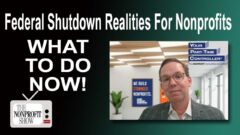
Derick Dreher of Your Part-Time Controller (YPTC) about what a federal budget stalemate really means for everyday nonprofit operations. Rather than getting lost in D.C. noise, Derick helps translate the process into plain decisions leaders can make right now. He distinguishes the big-picture spending framework from the agency-level appropriations that actually move money—and why, when competing continuing resolutions stall, operational pain shows up fast in grants, cash flow, and communications.
Derick is direct about timing and accountability. “Government shutdowns are very disruptive,” he notes, because grants staff are furloughed, portals can go dark, and payments pause. That doesn’t suspend your obligations: “If you have a report due date during the shutdown, you better send it in.” When systems are down, mailing with receipt becomes a practical move. He also cautions against attempting full drawdowns before costs are incurred; federal awards are reimbursement-based, and advances (if any) require clear permission and careful documentation.
The heart of the conversation is a workable to-do list. First, narrow your information sources: look to the National Council of Nonprofits, your state association, and trusted sector platforms rather than endless doom-scrolling. Second, contact program and fiscal officers now—before furloughs begin—to ask about extensions, submission methods, and any allowable advances. Third, communicate with stakeholders early so they don’t fill the silence with assumptions: explain what services could shift, what your contingency looks like, and how supporters can help.
On finance, Derick recommends tightening the cadence of cash views to weekly during uncertainty and building a scenario that assumes zero federal revenue for a period. That plan—reviewed with the board—becomes your “break glass” map if payments stall. Pair that with thoughtful revenue diversity (individuals, corporate, foundation, government) so a delay in one stream becomes a solvable liquidity challenge instead of an existential crisis.
Derick also flags a recent executive order on federal grantmaking that may slow timelines and alter risk: added political approvals, a preference for lower indirect rates, and a new termination clause could change how awards feel on the ground, at least temporarily. Agencies are emerging from a mandated pause, and budgets remain unsettled—so expect ambiguity, double down on documentation, and keep your communications clear and proactive.
The message is steady and usable: focus your inputs, talk to agencies now, model contingencies, and keep people in the loop. Preparedness here isn’t alarmist—it’s good stewardship under uncertainty.

Julia C. Patrick and Tony Beall turn board jitters into momentum with a simple, generous framework: four board roles that make fundraising feel natural, human, and actually fun. Julia sets the tone with a zinger that boards will remember: “This is not a no situation. This is a KNOW situation.” From there, Tony maps the path: “Prospector, cultivator, solicitor, and steward—four very simple roles that are really impactful.”
Prospectors spark the pipeline by looking at real relationships—LinkedIn, circles of influence, workplace connections—to spot people who might love your mission. Julia notes this is the one job every board member can do without sweaty palms. Cultivators then step in as brand ambassadors, sharing stories, hosting small gatherings, and learning what lights a supporter up—without making the ask. Think hype team with heart!
Next up: solicitors. Some board members truly enjoy asking (yes, unicorns exist). Tony clarifies that “strength in numbers” doesn’t mean bringing a stranger to the ask; the right voice in the room is the one with an authentic relationship. Finally, stewards keep the glow going—handwritten notes, quick calls, social shout-outs, tours—feeding the feedback loop so staff and board hear what donors feel and see. Introverts rejoice: stewardship offers tons of low-pressure ways to shine.
Julia and Tony keep it real about energy, fit, and growth. Not everyone will love every role, but everyone can contribute somewhere—and many will stretch into new skills with a little structure and encouragement. The pair celebrate their new book, The Architecture of Fundraising (artwork by Tony, applause from Julia), and salute Executive Producer Kevin Pace for nudging the dream into reality.
Bottom line: pick your lane, keep the lanes moving, and talk about them at every board meeting with intention. When board members match their temperament to the right role, confidence rises, the process hums, and your mission gets the fuel it deserves.
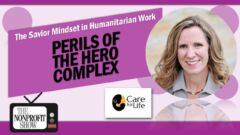
What if our best intentions were doing more harm than good? In this compelling and unflinchingly honest conversation, global humanitarian consultant Jen Brewer, Vice President at Care for Life, challenges the deeply ingrained dynamics behind the so-called “hero complex,” also known as the white savior complex.
Jen’s lived experience—once showing up with “20 suitcases full of stuff to give” to Guatemalan communities—serves as the jumping-off point for this raw and revealing discussion about what real help looks like. With decades of international service work, Jen isn’t interested in guilt trips or shame tactics. Instead, she invites a shift from paternalistic giving to genuine empowerment.
Care for Life’s Family Preservation Program in Mozambique provides a concrete model. Rather than offering handouts or short-term missions, they employ local staff to walk with entire communities through multi-year journeys of education, self-reliance, and sustainable growth. Jen makes clear: this isn’t about swooping in and saving people—it’s about listening, partnering, and trusting communities to lead themselves.
“The only tweak we needed to make,” Jen explains, “was to train their doctor—rather than replace them.” That small shift encapsulates her broader message: good intentions aren’t enough. Without humility, reflection, and a willingness to step back, well-meaning aid can unintentionally dismantle local economies, erode agency, and reinforce dependency.
She contrasts acute and chronic interventions, urging nonprofits to ask hard questions: Are we helping during a crisis—or perpetuating a crisis mindset for long-term issues like poverty? Are donors prepared to support systemic change instead of photo-worthy quick fixes?
The impactful discussion also surfaces the unspoken cultural programming behind American charity impulses—whether it's collecting coats for refugees or defaulting to physical donations over economic solutions. It’s not that action is wrong, Jen argues. It’s that the type of action matters—and often needs recalibrating.
Jen is not interested in charity that centers the giver. Instead, she calls for philanthropy that trusts and equips communities to solve their own problems—on their own terms. As she puts it, “If I have a program that requires me to run it, it’s a failure in progress.”
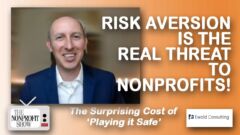
In a sector that thrives on purpose yet struggles with burnout, Paul Hanscom, Chief Growth Officer at Ewald Consulting, unpacks what happens when nonprofits become risk-averse after a crisis—and the surprising costs of playing it safe.
This conversation is a powerful challenge to nonprofit leaders: don’t retreat. The world is still changing—rapidly—and the organizations that will thrive are those who remember what got them through the last storm and are brave enough to face the next one head-on.
Paul, a Certified Association Executive (CAE), begins with a reflection on 20 years of working with nonprofit boards and executives. His insights span not just the tactical, but the philosophical: What is lost when an organization, once agile and responsive during the pandemic, slips back into indecision and overly cautious governance?
As Paul notes, “We’ve opened up people’s eyes and created new opportunities… they don’t want to go back to the way things used to be.” This sentiment fuels the entire conversation—a reminder that organizations grew stronger by being nimble, collaborative, and bold during the pandemic. Now, many are at risk of losing that momentum.
Paul addresses executive burnout and decision fatigue. Boards are often leaning harder on Executive Directors and CEOs, who are caught between exhausted staff and cautious boards. As Paul puts it, “The turnover rates for executive directors have never been higher.” This reality points to the need to reassess organizational culture—not with fear, but with clarity and courage.
This dynamic discussion considers the root of the sector’s current malaise. Is it fatigue? Fear? Habit? The answer, Paul suggests, lies in building a risk-aware culture—where calculated experimentation is embraced, failure is allowed within reason, and data is balanced with decisiveness. He shares a compelling example of a board reluctant to shift from a “C” level initiative to an “A” one, simply out of fear they’d land at an “F.” The longer they waited, the more performance declined. It’s a parable many in the sector will recognize.
Perhaps the most valued idea comes toward the end: technology will change, funding will fluctuate, but what remains is the need for belonging. Paul makes the case that associations—and nonprofits writ large—are uniquely positioned to fulfill that human desire for connection, identity, and authenticity. “There’s nothing quite like it elsewhere,” he says, “and the clearer we can communicate that to the world, the more we resonate.”
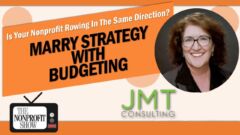
It’s budget season for nonprofits, and Dr. Stephanie Rose-Belcher, Chief Operating Officer at JMT Consulting, brings powerful insight to the table in this energizing session with host Julia Patrick. With over three decades of nonprofit sector expertise, JMT helps finance departments move from back-office cost centers to proactive strategy drivers—and Stephanie shows us how. Whether you’re preparing for the fiscal year or completely rethinking how your nonprofit builds financial strategy, this episode offers more than insight—it gives you a roadmap.
“We need to stop thinking of budgets as fixed and start treating them like what they really are—a living, breathing plan of action,” Stephanie begins. This instructive conversation lays out exactly how nonprofit leaders can reframe budgeting as a collaborative, mission-aligned process rather than a one-time spreadsheet task.
The conversation opens by emphasizing the necessity of starting with a strategic plan. Before anyone touches a budget template, the entire leadership team needs to align on long-term goals, funding mechanisms, and sustainability models. Only then does budgeting begin—with intention and purpose.
Stephanie urges nonprofit leaders to ditch the siloed approach. Budgeting shouldn't live with just the CFO. It must involve department heads, development teams, and the board to ensure full alignment between goals and resources. This transparency avoids the all-too-common tension that arises when program and development departments operate without a shared roadmap.
One standout tip: Build not one, but three budgets—best case, expected case, and worst case. “This isn’t just a COVID-era idea,” Stephanie asserts. Scenario planning is a best practice that strengthens resilience and foresight.
Stephanie also shares how benchmarking and key performance indicators (KPIs) can become tools for empowerment, not just financial oversight. When done right, they spark innovation and teamwork. Monthly forecasting and open communication about KPIs help leadership make smarter decisions and enable course corrections before things go off track.
But transparency must be handled with care. Stephanie offers practical advice on sharing financial realities without inciting panic. By pairing clear updates with actionable solutions, organizations can rally their teams around shared responsibility instead of fear.
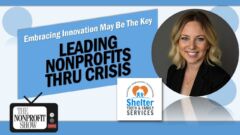
How do you lead when everything feels uncertain? Carina Santa Maria, CEO of Shelter Youth and Family Services, shared a bold, forward-thinking approach to nonprofit leadership in challenging times. From weathering funding impasses and the pandemic to rethinking donor relationships and pioneering new models of care, Carina proves that crisis can be a catalyst for transformation.
Shelter-Inc.org, based outside Chicago, has served vulnerable youth and families for 50 years. Yet Carina candidly shares that despite its legacy, the organization has had to reinvent itself multiple times. Whether navigating Illinois’ state budget freeze or pivoting during COVID-19, the common thread has been resilience backed by strategy. “We had to pivot and find the resources to make sure those services were delivered,” Carina says.
But this conversation is about more than survival—it's about rising. Carina reveals how she and her team moved away from event-based fundraising and focused on cultivating deep donor relationships. The result? A record-setting $1.8 million raised in one year—without galas or trivia nights. This change didn’t come easy, but it paid off with greater mission alignment and long-term investment from supporters.
Carina also discusses the organization's next bold chapter: building Illinois’ first DCFS-approved group home for child victims of human trafficking. What began as a donor’s $50,000 trust experiment has blossomed into a $5 million initiative. “He told me, ‘I don’t care if it works. I just want to see you think outside the box,’” Carina shares. It’s a stunning example of what’s possible when leaders are trusted and supported to innovate.
The episode touches on advocacy, trauma-informed storytelling, and building credibility through impact rather than sentiment. Carina makes a compelling case for nonprofit leaders to demand their place at decision-making tables and challenge outdated narratives that nonprofits are less strategic than their corporate counterparts.
For nonprofit professionals, this conversation is both a challenge and a blueprint. Carina reminds us that strategy, communication, and vision can carry organizations through uncertainty—not just intact, but stronger.
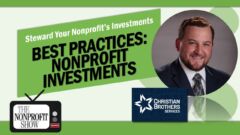
The Chief Investment Officer at Christian Brothers Services, Steve Sliwinski, offers a highly approachable yet technically sound guide to nonprofit investment strategy. With decades of financial experience and dual designations as CFA and CAIA, Steve breaks down how organizations—regardless of size—can begin managing and growing their financial assets responsibly.
From policy benchmarking and committee structure to modern investment tools and trends like IP transfers and crypto, Steve’s insights will help demystify what can often be an intimidating subject. This episode is a must-watch for boards, CFOs, and executive leaders seeking clarity on how to begin—or refine—their investment approach.
The discussion begins with a history of Christian Brothers Services, which evolved from a cooperative model among Catholic schools into a nationwide provider of retirement, insurance, and investment services for thousands of institutions. This story serves as an example of scalable collaboration and strategic vision, offering NPO’s a compelling model for shared resource management.
Steve explains that waiting for a major windfall to begin investing is outdated thinking. “It’s certainly not out of reach to create a well-diversified portfolio with under $100,000,” he shares, emphasizing that even small recurring contributions—like payroll-deducted retirement savings—can grow into substantial assets over time. The message: nonprofits don’t need to be large to think long-term.
Much of the conversation centers around the role of the investment committee. Steve offers a fresh take, stating that technical expertise isn’t always necessary. What matters most is “a long-term orientation and strategic mindset.” Ideal committee size? Three to seven individuals with high-level focus, not necessarily financial professionals.
The conversation, with host Julia Patrick, continues into policy development and investment alignment with mission. Steve discusses how ESG (environmental, social, governance) or values-based screening—once costly—is now affordable and feasible even for small organizations. He encourages nonprofits to create an investment policy document in partnership with a consultant or a platform like Vanguard or Fidelity to ensure thoughtful, repeatable decision-making. He stresses the importance of sticking with the strategy through market fluctuations: “Set the policy at the beginning, know why it exists, and abide by it—especially in difficult times.”

Jeffrey Wilcox (President) and Joan Brown (COO) of the Interim Executives Academy unpack the harsh realities of nonprofit leadership turnover—and the game-changing role of interim executives.
Jeffrey starts this lively session with. . . “Interim leaders aren’t temps—they’re bees, cross-pollinating wisdom to prepare organizations for their next leader.” Joan Brown backs it up, revealing why first-time nonprofit CEOs crash and burn—often due to unclear job expectations, chaotic HR structures, and boards that operate like secret societies instead of partners.
This bouyant conversation with host Julia Patrick, gets real fast:
HR disasters are the #1 reason leaders get fired—think vague job roles, favoritism, and financial denial.
Boards scare new execs by locking them out of meetings instead of mentoring them.
Interims aren’t just placeholders—they’re strategic fixers who spend 9–12 months prepping orgs for long-term success.
Looking ahead, Jeffrey and Joan warn nonprofits: “If you’re only relevant to yourself, you’re already dying.” The future demands sustainable leadership, emotional intelligence, and ditching outdated board models that hold orgs back.
